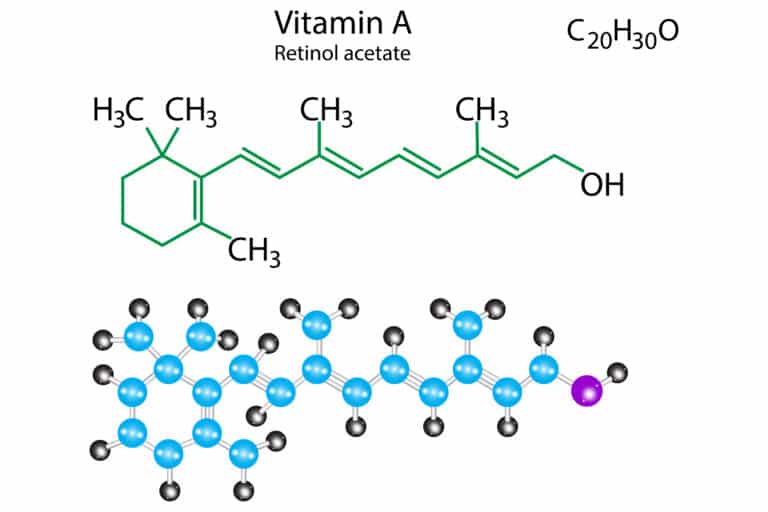Retinyl acetate

As an ester between acetic acid and retinol, retinyl acetate is one of the main forms of vitamin A. It is found in animal products such as liver and milk and is converted into retinol in the human organism. In contrast, retinyl acetate does not occur in plant products. Retinol is mainly known for its positive effect on our eyesight, the immune system and the skin and mucous membranes. In the worst case, a serious deficiency can lead to night blindness, because vitamin A serves as the basis for important visual pigments, which in turn make it possible to distinguish light from dark. Vitamin A also plays a major role in the development of cells and tissues.
Benefits of retinyl acetate
The chemical compound is often used in the cosmetics and pharmaceutical industries, but also in the production of animal feed, where it is authorised for all animal species (Regulation (EC) No 1831/2003 f). It is found in toothpaste as well as in cough drops and has recently attracted attention as a new innovative anti-ageing ingredient.
Whether in moisturisers and eye creams, in sunscreen products or in body lotions, retinyl acetate is no longer an exception in cosmetic formulations. There is a reason for this, because compared to conventional retinol, retinyl acetate offers a decisive advantage. Retinol is a very valuable radical scavenger, but at the same time it is extremely sensitive to oxidants, acids, light and air. Retinol esters such as retinyl acetate are much more stable in this respect.
Retinyl acetate in cosmetics
The compound is excellent for the treatment of dry scaly skin, but can also be used for impure and/or stressed skin. It reduces wrinkles caused by the environment, increases the elasticity of the skin and helps to stimulate cell renewal on the skin’s surface. Dead skin cells are shed faster and better. Retinyl acetate is also able to inhibit the breakdown of collagen.
At the same time, however, it also promotes the formation of new collagen, which also answers the question why retinyl acetate is preferably used in cosmetic products for mature skin. Here, the combination with vitamin C is particularly recommended. In this way, the antioxidant effect can develop in the best possible way. It is also used to reduce fine lines and wrinkles, improve skin texture and increase skin elasticity.
Disadvantage of retinyl acetate
It is also important to note that retinyl acetate, or products containing it, should be avoided during pregnancy and breastfeeding as it can increase skin sensitivity and there is insufficient evidence that it is safe.
Fact Sheet Retinyl Acetate
INCI: Retinyl acetate
CAS number: 127-47-9
Alternative names: Vitamin A acetate, all-trans-retinyl acetate.
Description: a yellow crystalline powder
Melting point: 57 to 58 degrees Celsius
Molecular formula: C22H32O2
Solubility: sparingly soluble in ethyl acetate, dichloromethane, and chloroform, almost insoluble in water
Retinyl acetate as an active ingredient for innovative cosmetic formulations
Retinol esters such as retinyl acetate are significantly more stable than retinol in terms of resistance to oxidation, light, air, and acids, but are just as effective. The active ingredient is ideal for sophisticated anti-ageing formulations and can visibly reduce wrinkles. It is well tolerated and gentler than retinol, which can cause skin irritation in some people. Or, to put it another way: retinyl acetate is an active ingredient that is tailor-made for modern and innovative cosmetic products that are particularly aimed at mature skin. Cosmacon is happy to develop high-quality and sophisticated formulations for you!
Literature
- Reversal of skin aging with topical retinoids; Bradley A Hubbard 1 , Jacob G Unger, Rod J Rohrich; Reconstr Surg 2014 Apr;133(4):481e-490e
- Tretinoin peel: a critical view.; Sumita JM, Leonardi GR, Bagatin E; Bras Dermatol. 2017 May-Jun;92(3):363-366
- Isotretinoin and Timing of Procedural Interventions: A Systematic Review With Consensus Recommendations.Spring LK, Krakowski AC, Alam M, Bhatia A, Brauer J, Cohen J, Del Rosso JQ, Diaz L, Dover J, Eichenfield LF, Gurtner GC, Hanke CW, Jahnke MN, Kelly KM, Khetarpal S, Kinney MA, Levy ML, Leyden J, Longaker MT, Munavalli GS, Ozog DM, Prather H, Shumaker PR, Tanzi E, Torres A, Velez MW, Waldman AB, Yan AC, Zaenglein AL.; JAMA Dermatol. 2017 Aug 1;153(8):802-809
- Topical Over-the-Counter Antiaging Agents: An Update and Systematic Review.; Imhof L, Leuthard D.; Dermatology. 2021;237(2):217-229
- Skin aging: Pathophysiology and innovative therapies; Boismal F, Serror K, Dobos G, Zuelgaray E, Bensussan A, Michel L.; Med Sci (Paris). 2020 Dec;36(12):1163-1172
- A randomized, double-blind, controlled comparative trial of the anti-aging properties of non-prescription tri-retinol 1.1% vs. prescription tretinoin 0.025%; Elizabeth T Ho , Nathan S Trookman, Brian R Sperber, Ronald L Rizer, Ralph Spindler, Sujatha Sonti, Vincent Gotz, Rahul Mehta; J Drugs Dermatol 2012 Jan;11(1):64-9
- Theoretical Study of the Photoisomerization Mechanism of All-Trans-Retinyl Acetate.; Kochman MA, Palczewski K, Kubas A.; J Phys Chem A. 2021 Sep 30;125(38):8358-8372
- Design and Engineering of “Green” Nanoemulsions for Enhanced Topical Delivery of Bakuchiol Achieved in a Sustainable Manner: A Novel Eco-Friendly Approach to Bioretinol.; Lewińska A, Domżał-Kędzia M, Maciejczyk E, Łukaszewicz M, Bazylińska U.; Int J Mol Sci. 2021 Sep 18;22(18):10091
- Effects of Topical Retinoids on Acne and Post-inflammatory Hyperpigmentation in Patients with Skin of Color: A Clinical Review and Implications for Practice. Callender VD, Baldwin H, Cook-Bolden FE, Alexis AF, Stein Gold L, Guenin E.Am J Clin Dermatol. 2022 Jan;23(1):69-81
- Arnhold: Der Begriff „Retinoide“ In: Untersuchungen zum Metabolismus von Vitamin A / Retinoiden im Hinblick auf eine Risikoabschätzung ihrer teratogenen Wirkung beim Menschen; S.2; Dissertation; Braunschweig, 07.03.2000
- Anti-Irritant Strategy against Retinol Based on the Genetic Analysis of Korean Population: A Genetically Guided Top-Down Approach. Kang S, Kim K, Jun SH, Lee S, Kim J, Shin JG, Kim Y, Kim M, Park SG, Kang NG.Pharmaceutics. 2021 Nov 25;13(12):2006